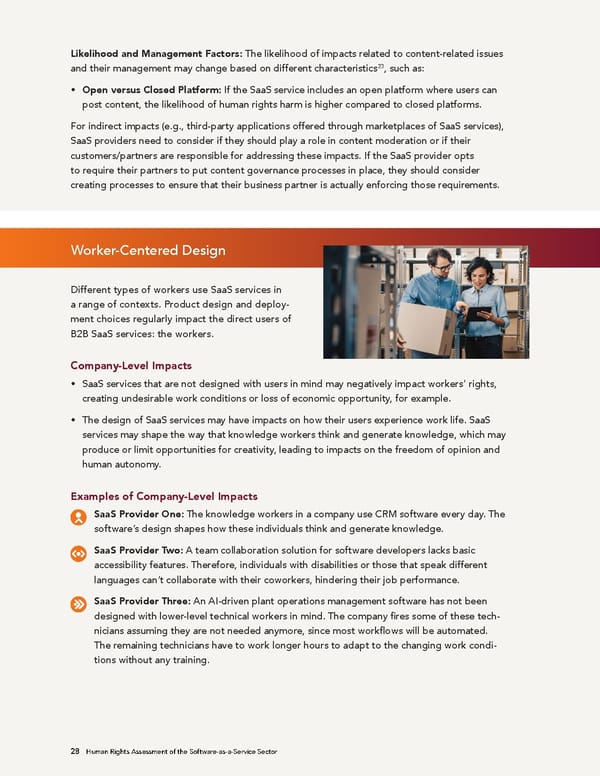Likelihood and Management Factors: The likelihood of impacts related to content-related issues 23 and their management may change based on different characteristics , such as: • Open versus Closed Platform: If the SaaS service includes an open platform where users can post content, the likelihood of human rights harm is higher compared to closed platforms. For indirect impacts (e.g., third-party applications offered through marketplaces of SaaS services), SaaS providers need to consider if they should play a role in content moderation or if their customers/partners are responsible for addressing these impacts. If the SaaS provider opts to require their partners to put content governance processes in place, they should consider creating processes to ensure that their business partner is actually enforcing those requirements. Worker-Centered Design Different types of workers use SaaS services in a range of contexts. Product design and deploy- ment choices regularly impact the direct users of B2B SaaS services: the workers. Company-Level Impacts • SaaS services that are not designed with users in mind may negatively impact workers’ rights, creating undesirable work conditions or loss of economic opportunity, for example. • The design of SaaS services may have impacts on how their users experience work life. SaaS services may shape the way that knowledge workers think and generate knowledge, which may produce or limit opportunities for creativity, leading to impacts on the freedom of opinion and human autonomy. Examples of Company-Level Impacts SaaS Provider One: The knowledge workers in a company use CRM software every day. The software’s design shapes how these individuals think and generate knowledge. SaaS Provider Two: A team collaboration solution for software developers lacks basic accessibility features. Therefore, individuals with disabilities or those that speak different languages can’t collaborate with their coworkers, hindering their job performance. SaaS Provider Three: An AI-driven plant operations management software has not been designed with lower-level technical workers in mind. The company fires some of these tech- nicians assuming they are not needed anymore, since most workflows will be automated. The remaining technicians have to work longer hours to adapt to the changing work condi- tions without any training. 28 Human Rights Assessment of the Software-as-a-Service Sector
 Human Rights Assessment of the Software-as-a-Service Sector Page 28 Page 30
Human Rights Assessment of the Software-as-a-Service Sector Page 28 Page 30